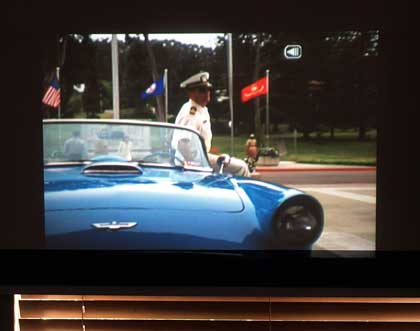Optoma Pico Menus
Talk about easy! The Pico has no menus. This is strictly a plug in your source, turn it on, and project. There are no color controls, or any other controls for that matter.
Remote Control
There's no remote control either! Afterall, the only feature a remote could control, would be the power, since there is only one input and that is the composite video input.
Optoma Pico Lens Throw
The lens is fixed - no zoom. The ratio of the lens itself is 1.9:1 - that is, the distance from the screen is 1.9 times the width of the projected image. Thus, to project a 20 inch wide image (25 inches diagonal), the projector would be placed 1.9 x 20 inches from the surface you are projecting on. In this example, 38 inches back.
Lens Shift
Not only is there no adjustable lens shift, but there is no lens offset either. The correct placement of the projector is so that the lens is centered relative to your screen. That means it should be at the same height as the middle of the screen, and half way between the two sides. Place it there, and you get a nice rectangular image. Place it below (or above), and you get the usual trapazoidal shape with the image wider at the top (or the bottom). The Pico doesn't have any keystone correction, which is used in larger projectors without lens shift, to adjust a trapazoidal image back to a rectangular one.
Optoma Pico - Image Quality
Optoma Pico Projector - Picture Quality
The Pico isn't about great picture quality, but about having a micro-sized device that will allow you to put up an image from a video source, including some hand held game machines, iPhones, and other portable devices. The picture is decent (watchable), but won't satisfy anyone hoping for anything resembling home theater picture quality. Resolution is also low, being half of standard VGA (480x320 - whereas VGA is 640x480). There is no way to output an HDTV resolution image to the Optoma Pico. I did watch a few minutes of one of the NBA playoffs on the projector, and it was very acceptable, all considered. I was projecting about a 25 inch diagonal image, to maintain some basic level of brightness, using a screen and a darkened room. Sure beats trying to watch the same on some tiny 3 or 5 inch diagonal display!
Flesh Tones
We didn't run a grayscale measurement on the Pico, so I have no numbers to indicate whether the image is too warm (red) or cool (blue). In reality, the skin tones tend to have a bit much on red, but the real problem is not the color balance, but ovesaturation (and a high gamma) making for dark, oversaturated skin tones. Those characteristics are far more significant than any color shift in the skin tones.
Optoma Pico Black Levels & Shadow Detail
Well, the Pico sure isn't a real home theater projector, but since it will be used primarily by folks viewing video and gaming, it's worth mentioning how it does on both black levels and shadow detail. Black levels actually aren't bad. The 1000:1 contrast ratio is still well below all but a couple of the most entry level home theater projectors, and are fairly black. Considering the low expectations for high quality video reproduction that pico sized projectors produce, the Pico does a reasonably good job. Dark shadow detail, isn't really bad, but the projector is definitely losing a fair amount of the darkest detail. That may well be in part due to the constrasty look of the image, and the over saturation.
Optoma Pico - Overall Color & Picture Quality
The Optoma Pico leaves much to be desired overall, if you are comparing it to larger projectors, especially home theater models, but even compared to basic, entry level 3LCD business projectors. The primary weakness is that the image is overly saturated. Colors are ok, but hardly great. Everything for the most part appears a bit over the top.
On the other hand, it's ability to produce bright reds and yellows - normally a weakness of DLP business projectors, isn't bad for this tiny DLP projector. You won't be buying the Pico for its image quality, but, rather for it's size and portability. Don't set your expectations too high, but sure, you may well enjoy watching a movie on it, if you keep the screen size small (typically 20 to 50 inches diagonal, in a darkened room. As you can see in the image above, the blue of the Thunderbird, is nice and rich, but you can also see the oversaturated, contrasty, and too dark, skin tones when you look at Kelsey Grammer's face. As I have said, watchable, but not home theater quality.
 Click Image to Enlarge
Click Image to EnlargeOptoma Pico Projector: Performance, HDTV, TV and Sports
Again, the primary weaknesses are oversaturated colors, and limited brightness. If you can live with both of those, the Pico should serve you nicely, for watching TV, including sports. Since the only signal you can feed the Pico is composite video, you certainly can't expect HDTV quality performance. Still, as with movies, in a pinch, the Pico can do a decent job of projecting your favorite football game, or TV show on to a wall, when you are traveling.
When it comes to gaming, I'm not much help. I briefly put up Carbon Canyon (auto racing) from my PS3, and it worked reasonably well, but truth is, I'm not a gamer (that's one of only two games I even own for my PS3s). I plan to try out some of my sports games that I have for my Wii, but haven't gotten to that yet. I will comment after I have had a chance. Some hand held game machines such as the PSP 3000 do have a composite video output, and will work with the Pico. The popular Nintendo DS, however does not.


